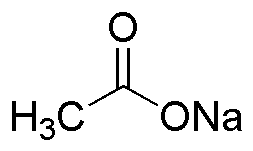Sodium acetate, anhydrous is widely utilized in research focused on:
- Food Preservation: It acts as a food additive, helping to regulate acidity and enhance flavor in processed foods, ensuring longer shelf life.
- Buffer Solutions: Commonly used in laboratories, it helps maintain pH levels in biochemical experiments, providing stability for various reactions.
- Textile Industry: Employed in dyeing processes, it improves the fixation of dyes on fabrics, resulting in vibrant colors and better wash fastness.
- Pharmaceuticals: Utilized in the formulation of certain medications, it aids in drug delivery systems, enhancing the solubility of active ingredients.
- Heating Pads: Its ability to release heat upon crystallization makes it ideal for reusable heating pads, providing a convenient solution for pain relief.
Informations générales
Propriétés
Sécurité et réglementation
Applications
Sodium acetate, anhydrous is widely utilized in research focused on:
- Food Preservation: It acts as a food additive, helping to regulate acidity and enhance flavor in processed foods, ensuring longer shelf life.
- Buffer Solutions: Commonly used in laboratories, it helps maintain pH levels in biochemical experiments, providing stability for various reactions.
- Textile Industry: Employed in dyeing processes, it improves the fixation of dyes on fabrics, resulting in vibrant colors and better wash fastness.
- Pharmaceuticals: Utilized in the formulation of certain medications, it aids in drug delivery systems, enhancing the solubility of active ingredients.
- Heating Pads: Its ability to release heat upon crystallization makes it ideal for reusable heating pads, providing a convenient solution for pain relief.
Documents
Fiches de données de sécurité (FDS)
La FDS fournit des informations de sécurité complètes sur la manipulation, le stockage et l’élimination du produit.
Spécifications du produit (PS)
Le PS fournit une description complète des propriétés du produit, notamment sa composition chimique, son état physique, sa pureté et les exigences de stockage. Il détaille également les plages de qualité acceptables et les applications prévues du produit.
Certificats d'analyse (COA)
Recherchez des certificats d'analyse (COA) en saisissant le numéro de lot du produit. Les numéros de lot et de lot se trouvent sur l'étiquette d'un produit, après les mots « Lot » ou « Lot de fabrication ».
Numéro de catalogue
Numéro de lot/série
Certificats d'origine (COO)
Ce certificat d'exploitation confirme le pays dans lequel le produit a été fabriqué, et détaille également les matériaux et composants utilisés et s'il est issu de sources naturelles, synthétiques ou autres sources spécifiques. Ce certificat peut être requis pour les douanes, le commerce et la conformité réglementaire.
Numéro de catalogue
Numéro de lot/série
Fiches de données de sécurité (FDS)
La FDS fournit des informations de sécurité complètes sur la manipulation, le stockage et l’élimination du produit.
DownloadSpécifications du produit (PS)
Le PS fournit une description complète des propriétés du produit, notamment sa composition chimique, son état physique, sa pureté et les exigences de stockage. Il détaille également les plages de qualité acceptables et les applications prévues du produit.
DownloadCertificats d'analyse (COA)
Recherchez des certificats d'analyse (COA) en saisissant le numéro de lot du produit. Les numéros de lot et de lot se trouvent sur l'étiquette d'un produit, après les mots « Lot » ou « Lot de fabrication ».
Numéro de catalogue
Numéro de lot/série
Certificats d'origine (COO)
Ce certificat d'exploitation confirme le pays dans lequel le produit a été fabriqué, et détaille également les matériaux et composants utilisés et s'il est issu de sources naturelles, synthétiques ou autres sources spécifiques. Ce certificat peut être requis pour les douanes, le commerce et la conformité réglementaire.


